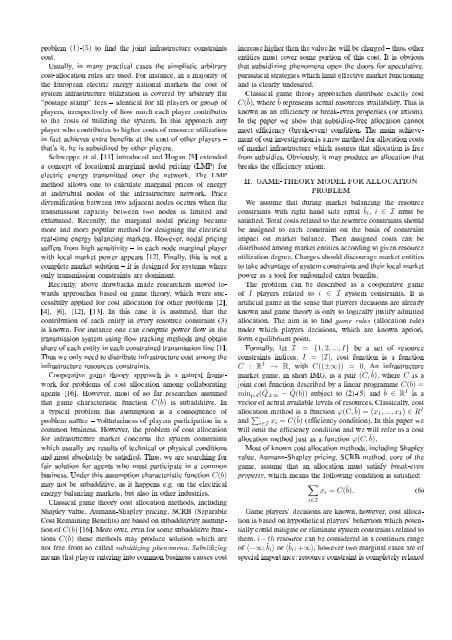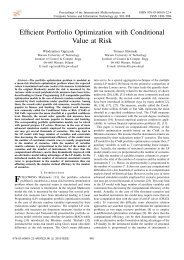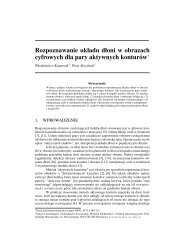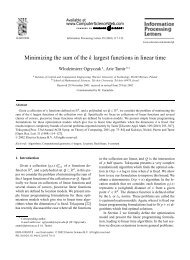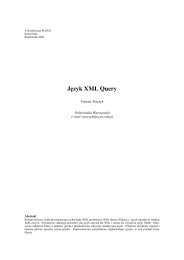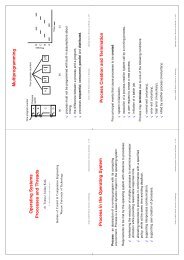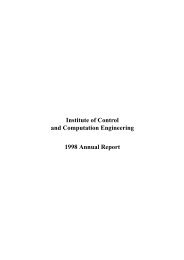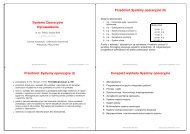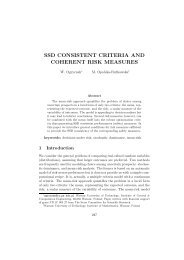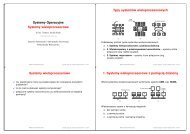Subsidize-free cost allocation method for infrastructure ... - Ozyrys
Subsidize-free cost allocation method for infrastructure ... - Ozyrys
Subsidize-free cost allocation method for infrastructure ... - Ozyrys
You also want an ePaper? Increase the reach of your titles
YUMPU automatically turns print PDFs into web optimized ePapers that Google loves.
problem (1)-(5) to nd the joint <strong>infrastructure</strong> constraints<br />
<strong>cost</strong>.<br />
Usually, in many practical cases the simplistic arbitrary<br />
<strong>cost</strong>-<strong>allocation</strong> rules are used. For instance, in a majority of<br />
the European electric energy national markets the <strong>cost</strong> of<br />
system <strong>infrastructure</strong> utilization is covered by arbitrary at<br />
”postage stamp” fees – identical <strong>for</strong> all players or group of<br />
players, irrespectively of how much each player contributes<br />
to the <strong>cost</strong>s of utilizing the system. In this approach any<br />
player who contributes to higher <strong>cost</strong>s of resource utilization<br />
in fact achieves extra benets at the <strong>cost</strong> of other players –<br />
that's it, he is subsidized by other players.<br />
Schweppe et al. [11] introduced and Hogan [5] extended<br />
a concept of locational marginal nodal pricing (LMP) <strong>for</strong><br />
electric energy transmitted over the network. The LMP<br />
<strong>method</strong> allows one to calculate marginal prices of energy<br />
at individual nodes of the <strong>infrastructure</strong> network. Price<br />
diversication between two adjacent nodes occurs when the<br />
transmission capacity between two nodes is limited and<br />
exhausted. Recently, the marginal nodal pricing became<br />
more and more popular <strong>method</strong> <strong>for</strong> designing the electrical<br />
real-time energy balancing markets. However, nodal pricing<br />
suffers from high sensitivity – in each node marginal player<br />
with local market power appears [12]. Finally, this is not a<br />
complete market solution – it is designed <strong>for</strong> systems where<br />
only transmission constraints are dominant.<br />
Recently, above drawbacks made researchers moved towards<br />
approaches based on game theory, which were successfully<br />
applied <strong>for</strong> <strong>cost</strong> <strong>allocation</strong> <strong>for</strong> other problems [2],<br />
[4], [6], [12], [13]. In this case it is assumed, that the<br />
contribution of each entity in every resource constraint (3)<br />
is known. For instance one can compute power ow in the<br />
transmission system using ow tracking <strong>method</strong>s and obtain<br />
share of each entity in each constrained transmission line [1].<br />
Thus we only need to distribute <strong>infrastructure</strong> <strong>cost</strong> among the<br />
<strong>infrastructure</strong> resources constraints.<br />
Cooperative game theory approach is a natural framework<br />
<strong>for</strong> problems of <strong>cost</strong> <strong>allocation</strong> among collaborating<br />
agents [16]. However, most of so far researches assumed<br />
that game characteristic function C(b) is subadditive. In<br />
a typical problem this assumption is a consequence of<br />
problem nature – voluntariness of players participation in a<br />
common business. However, the problem of <strong>cost</strong> <strong>allocation</strong><br />
<strong>for</strong> <strong>infrastructure</strong> market concerns the system constraints<br />
which usually are results of technical or physical conditions<br />
and must absolutely be satised. Thus, we are searching <strong>for</strong><br />
fair solution <strong>for</strong> agents who must participate in a common<br />
business. Under this assumption characteristic function C(b)<br />
may not be subadditive, as it happens e.g. on the electrical<br />
energy balancing markets, but also in other industries.<br />
Classical game theory <strong>cost</strong> <strong>allocation</strong> <strong>method</strong>s, including<br />
Shapley value, Aumann-Shapley pricing, SCRB (Separable<br />
Cost Remaining Benets) are based on subadditivity assumption<br />
of C(b) [16]. More over, even <strong>for</strong> some subadditive functions<br />
C(b) these <strong>method</strong>s may produce solution which are<br />
not <strong>free</strong> from so called subsidizing phenomena. Subsidizing<br />
means that player entering into common business causes <strong>cost</strong><br />
increase higher then the value he will be charged – thus, other<br />
entities must cover some portion of this <strong>cost</strong>. It is obvious<br />
that subsidizing phenomena open the doors <strong>for</strong> speculative,<br />
parasitical strategies which limit effective market functioning<br />
and is clearly undesired.<br />
Classical game theory approaches distribute exactly <strong>cost</strong><br />
C(˜b), where ˜b represents actual resources availability. This is<br />
known as an efciency or break-even properties (or axiom).<br />
In the paper we show that subsidize-<strong>free</strong> <strong>allocation</strong> cannot<br />
meet efciency (break-even) condition. The main achievement<br />
of our investigation is a new <strong>method</strong> <strong>for</strong> <strong>allocation</strong> <strong>cost</strong>s<br />
of market <strong>infrastructure</strong> which assures that <strong>allocation</strong> is <strong>free</strong><br />
from subsidies. Obviously, it may produce an <strong>allocation</strong> that<br />
breaks the efciency axiom.<br />
II. GAME-THEORY MODEL FOR ALLOCATION<br />
PROBLEM<br />
We assume that during market balancing the resource<br />
constraints with right hand side equal ˜b i , i ∈ I must be<br />
satised. Total <strong>cost</strong>s related to the resource constraints should<br />
be assigned to each constraint on the basis of constraint<br />
impact on market balance. Then assigned <strong>cost</strong>s can be<br />
distributed among market entities according to given resource<br />
utilization degree. Charges should discourage market entities<br />
to take advantage of system constraints and their local market<br />
power as a tool <strong>for</strong> unfounded extra benets.<br />
The problem can be described as a cooperative game<br />
of I players related to i ∈ I system constraints. It is<br />
articial game in the sense that players decisions are already<br />
known and game theory is only to logically justify admitted<br />
<strong>allocation</strong>. The aim is to nd game rules (<strong>allocation</strong> rule)<br />
under which players decisions, which are known apriori,<br />
<strong>for</strong>m equilibrium point.<br />
Formally, let I = {1, 2, ..., I} be a set of resource<br />
constraints indices, I = |I|, <strong>cost</strong> function is a function<br />
C : R I → R, with C((±∞)) = 0. An <strong>infrastructure</strong><br />
market game, in short IMG, is a pair (C, ˜b), where C is a<br />
joint <strong>cost</strong> function described by a linear programme C(b) =<br />
min p,d ( ˆQ ±∞ − ˆQ(b)) subject to (2)-(5) and ˜b ∈ R I is a<br />
vector of actual available levels of resources. Classically, <strong>cost</strong><br />
<strong>allocation</strong> <strong>method</strong> is a function ϕ(C, ˜b) = (x 1 , ..., x I ) ∈ R I<br />
and ∑ i∈I x i = C(˜b) (efciency condition). In this paper we<br />
will omit the efciency condition and we will refer to a <strong>cost</strong><br />
<strong>allocation</strong> <strong>method</strong> just as a function ϕ(C, ˜b).<br />
Most of known <strong>cost</strong> <strong>allocation</strong> <strong>method</strong>s, including Shapley<br />
value, Aumann-Shapley pricing, SCRB <strong>method</strong>, core of the<br />
game, assume that an <strong>allocation</strong> must satisfy break-even<br />
property, which means the following condition is satised:<br />
∑<br />
x i = C(˜b). (6)<br />
i∈I<br />
Game players' decisions are known, however, <strong>cost</strong> <strong>allocation</strong><br />
is based on hypothetical players' behaviors which potentially<br />
could mitigate or eliminate system constraints related to<br />
them. i − th resource can be considered in a continues range<br />
of 〈−∞; ˜b i 〉 or 〈˜b i ; +∞〉, however two marginal cases are of<br />
special importance: resource constraint is completely relaxed


